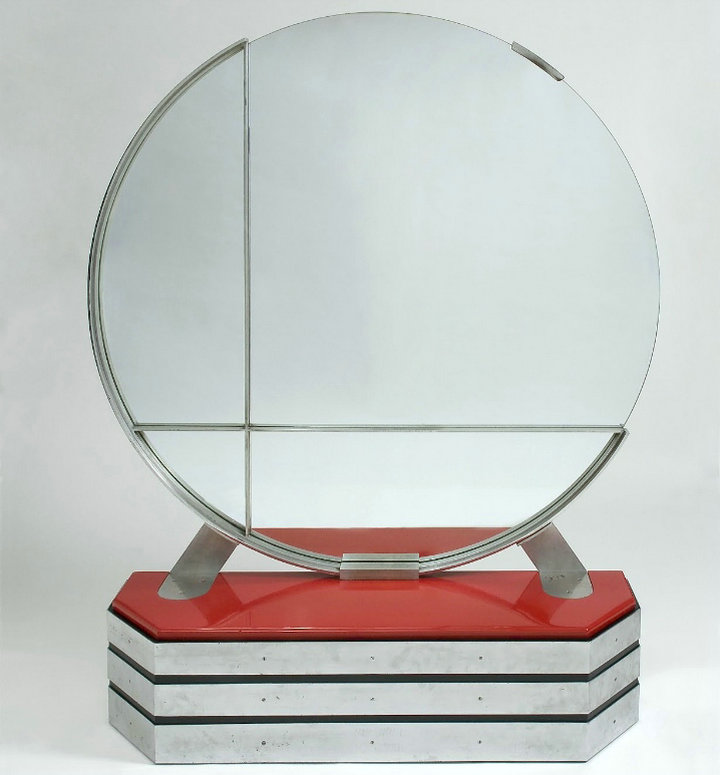Paul T. Frankl (October 14, 1886 – March 21, 1958), an architect, Art Deco designer, prolific painter and writer born in Vienna (Austria). Frankl brought a new perspective and enthusiasm to forge a typically American aesthetic. Between the two world wars, he has more than any other designer, helped shape the distinctive style of American modernism.
Frankl, bron in a wealthy family, studied architecture at the Polytechnic Institute in Berlin. After Frankl completed his architectural studies at the Berlin Polytechnic, he traveled, spending time in Berlin and Copenhagen before arriving in the United States in April 1914. After graduating, he began traveling to Copenhagen and the United States, where he arrived in New York in 1914 and was seduced by the majestic skyline of the city. He settled in New York City and brought with him an outsider’s fresh perspective and an enthusiasm for forging a uniquely American design aesthetic.
Frankl began as an architect and later switched to designing and painting fine art and furniture. In the years between the two world wars he, more than any other designer, helped shape the distinctive look of American modernism.
In the 1920s, he introduced his celebrated skyscraper style (before turning to metal furnishings in the 1930s). Frankl opened Frankl Galleries on 48th Street, calling his company Skyscraper Furniture, which became an epicenter of American modernism, including modern textiles and wallpapers imported from Europe.
He opened a gallery in 1922, on 48th Street, and in 1924 a showroom on Madison Avenue; In addition to textiles and wallpapers imported from Europe, he sells furniture of his own design, usually offices and libraries, but also lamps; Stylish, no-frills pieces of a new, typically American style, that reflect the advances in innovative technology and changes in culture. From 1925, his creations evoke the skyscrapers of New York, in that they are tall and narrow to hold in the small apartments of the city. They are immediately adopted and give it fame. The gallery is renamed “Skyscrapers Furniture” and becomes the epicenter of American modernism.
He was a member of the American Union of Decorative Artists and Craftsmen (AUDAC), formed in 1927. He also designs posters, and sets theater.
His solo art shows included New York City’s Knoedler Gallery in 1931 and Los Angeles’s Stendahl Gallery in 1944.
After he later relocated to Los Angeles and opened a gallery on Rodeo Drive in Beverly Hills.
Architecture and the decorative arts responded dramatically to the urban sensibility that flourished between the world wars. The new materials and mechanized techniques of the twentieth century demanded new forms. Furniture designers were inspired by the skyscraper building boom of the 1920s, and Frankl in particular incorporated the new aesthetic of architecture into his furniture designs. He is best known for his “skyscraper” furniture of the 1920s and 1930s—desks, cabinets, and bookcases that incorporated elements of various heights in imitation of the skyscraper. Frankl imagined this furniture as solving the problem of cramped apartment living in the same way as the skyscraper solved the problem of urban growth.
In parallel, he wrote several books and magazine articles on Modern Style, becoming his representative. He also painted and exhibited in galleries: Galerie Knoedler (NYC), 1931 (solo); LA Junior College, 1936; Galerie Stendhal (LA), 1944 (solo).
In 1934, he settled in Los Angeles, teaches at the USC and at the Chouinard Art Institute. He also opens a gallery on Rodeo Drive becoming an interior decorator in Beverly Hills. Very quickly his clientele grew with clients such as Fred Astaire, Cary Grant, Katharine Hepburn, Walter Huston and Alfred Hitchcock.
Frankl wrote several books and magazine articles about the Modern Style and was its most vocal proponent. He later designed production pieces for Brown Saltman of California and Johnson Furniture Company of Grand Rapids, incorporating an early use of biomorphic designs and novel materials such as cork veneer. His style continuously evolved, from early skyscraper furniture to relaxed and casual designs favored by the Hollywood elite in the 1930s to manufactured pieces for the mass market in the 1950s. In 1934 he moved to Los Angeles where he taught at the University of Southern California and the Chouinard Art Institute. Used, out-of-print books he authored sell for hundreds of dollars in online bookstores.
Its Art Deco style will be called there, the modern California style. The public will discover the style of Frankl by the films, will be conquered and will like the same. The furniture will be manufactured by Brown & Saltzman of California and the Johnson Furniture Company of Grand Rapids. In his creations Krankl experimented with innovative shapes and materials such as cork veneer, metal, glass and bakelite.
His daughter, Paulette Frankl, is an artist, author and photographer, and his grandson, Nicholas Koenig, is a creative director for theme parks and interactive games.
